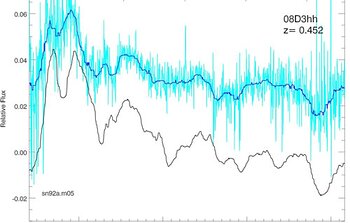The Last Supernova Legacy Survey Spectrum
July 5, 2008

The Supernova Legacy Survey (SNLS) had ambitious goals from the start - to produce a definitive sample of distant supernovae for cosmology. The aim was not only to find an order-of-magnitude more distant supernovae than previous surveys, but study them with higher precision. Such a dataset has the potential to distinguish between theories for the mysterious Dark Energy that appears to be causing the expansion of the Universe to accelerate.
The 5-year survey began in 2003 and the final supernova spectrum was recently taken at Gemini North (Fig. 1). The survey has been a great success, generating over 400 spectroscopically confirmed Type Ia supernovae. This has been achieved by the international SNLS team using a combination of survey images from CFHT, (obtained from the "Deep" part of the CFHT Legacy Survey), and spectroscopic follow-up using the worlds largest ground-based telescopes including Gemini North and South, VLT, Keck and Magellan. The resulting dataset is the largest homogenous set of light-curves and spectra of supernovae at high redshifts.
Gemini's key role was to provide spectroscopic redshifts and classification of the supernova types for the most distant (and hence faintest) supernova candidates. The Nod-and-Shuffle mode on the GMOS instruments made this possible by greatly reducing systematic effects associated with sky subtraction.
The queue mode at Gemini was also a crucial factor. Supernova candidates were found continuously in "rolling-search" mode, and the follow-up spectroscopy was scheduled when the conditions were right for these faint targets (good seeing and dark sky background).
In total we have over 500 hours of data from Gemini (North and South combined) and observed about 230 objects, some of them more than once.
The SNLS has already produced more than 15 publications in refereed journals on a range of subjects that include:
- constraints on models for dark energy;
- supernova rates;
- tests for evolution in the supernova population;
- measurements of ultra-violet properties of supernovae;
- clustering of supernova host galaxies;
- unusual supernovae; and
- the physics of SN explosions.
In addition this work advanced survey methods, including improvements in real-time classification of supernovae.
We are now analyzing the data to produce the tightest constraints yet on the properties of Dark Energy. Our preliminary finding is that Dark Energy behaves like Einstein's Cosmological Constant, to a precision of about 10%. So far the first three years of data have been analyzed and the results are nearly ready for publication. Fully exploiting the final 5 year dataset will keep the SNLS team busy for awhile! In terms of sample size and quality, the SNLS dataset is unlikely to be surpassed for many years. The next major advances are likely to be made through large, high-quality samples of supernovae at smaller distances than covered by SNLS, and from future, major ground and/or space-based SN searches at higher redshifts.
Links
- For more information on the SNLS please see the survey's webpage.

